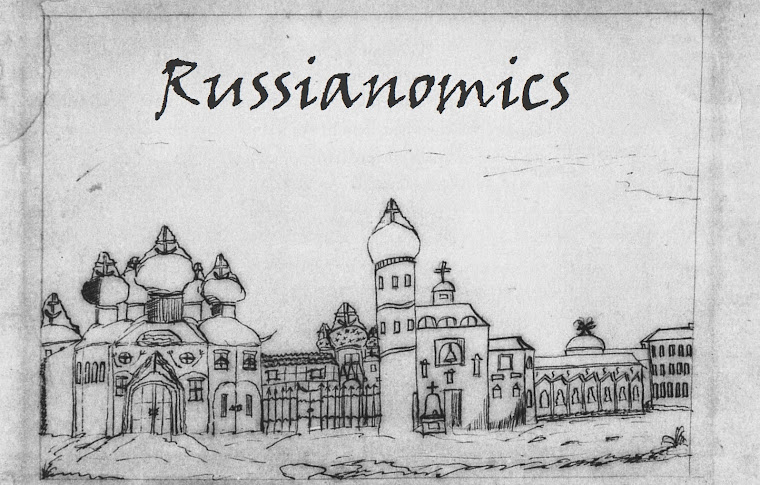Low oil prices have been a strain on Russia's federal budget this year. The Finance Ministry is expecting a deficit around 3% of the Russian GDP for 2015. Although the current recession in Russia is expected to end in 2016, the budget forecast for 2016 does not look any better. In the budget draft accepted by the Russian Duma today, the deficit reaches 3% of GDP yet again. It is based on an average oil price of $50/barrel. Currently, the price for Urals oil is just above $40.
It is clear that at current oil prices, trouble is ahead for Russia's state finances. But how soon will the reserves run out? There seems to be some confusion about the actual size of the reserves. For example, a Stratfor report counted $515.43 billion (the report is accessible if you google for "Russia Prepares to Tighten Spending in 2016"). However, there seems to be an error in their calculation. They added the international reserves as published by the Russian central bank ($371.26 billion) to the size of the National Wealth Fund (NWF, $73.66 billion) and the National Reserve Fund (NRF, $70.51 billion). The problem is that the NWF and NRF are already included in the $371.26 billion. Thus, Stratfor is exaggerating the Russian reserves by about $144 billion dollars.
The National Reserve Fund and the National Wealth Fund are the most important indicators for the sustainability of Russian state finances. The NRF is designed to be budget buffer. It is replenished from budget surpluses until it reaches 10% of GDP - all surpluses beyond that are used transferred to the NWF. The NWF was designed to be a safeguard for the pension system. However, with law changes it can also - and most likely will - be used for financing a budget deficit.
Both the NRF and NWF are supposed to be invested in dollar (45%), euro (45%) and British Pound (10%). The size and the composition of the funds is constantly changing slightly because of changes in exchange rates. For example, the NWF was about $6 billion smaller in November 2015 than in January 2015, because the Euro lost 10% of its value against the Dollar during that time. There have been no large transfers involving the NWF until now.
The 2015 budget deficit is being financed with the National Reserve Fund. There were several withdrawals during this year. At the 1st of December 2015, the NRF is $29 billion smaller than in January 2015 (it went from $88 billion to $59 billion). Throughout the year, there were several withdrawals which were used for the federal budget.
The withdrawal of funds serves two different purposes at the same time. On the one hand, the money is used for budget financing. On the other hand, the withdrawals allow the central bank to support the Ruble. The reason is that the freed Euro/Dollar/British Pound investments can be converted into Rubles, creating additional demand for the Russian currency.
To this point, the changes in the Reserve Fund do not look dramatic. However, towards the end of the year there may be additional larger withdrawals. In the end of October, Russian finance minister Siluanov estimated the Reserve fund to shrink to 2,6 trillion Rubles by the end of the year. This estimate is included as a dotted line in the following diagram:
SUMMARY - How long will Russia's reserves last? If the finance minister is right, the NRF will fall to 3,6% of the Russian GDP this year. The budget deficit for next year is planned to be 3% of GDP, meaning that about 0,6% of the NRF would be left in the end of 2016. However, the budget assumes an average oil price which is 20%-25% higher than the actual oil price today. This is why Siluanov has already warned that the NRF will be empty before the end of next year.
If the NRF is gone, this is of course not the end of days for the Russian state. The next reserves to be tapped into is obviously the National Wealth Fund, which would last another two years at current oil prices (until 2018). If the oil price has not recovered significantly by 2018 (i.e. after Putin's probable reelection) the Russian government might try to issue bonds (downside: high interest payments) or sell bonds to the central bank, effectively printing Rubles (downside: inflation will go up). Dramatic budget cuts would be another solution. A combination of all three measures is the most likely outcome.
Overall, the forecast is not looking too bright. Without rallying oil prices there is stormy weather ahead for Russian state finances around 2018. Should economics eventually "rock the boat" in Russia, Putin truly needs an experienced an trusted navigator, which may be the reason for former finance minister Kudrin's expected return to the Kremlin.
*During the mass protests in Russia, Putin called upon the opposition to "not rock the boat". Eventually, OMON police forces and arrests silenced the opposition.
All charts are based on data from minfin.ru
Website of the author: http://www.janis-kluge.com




Keine Kommentare:
Kommentar veröffentlichen